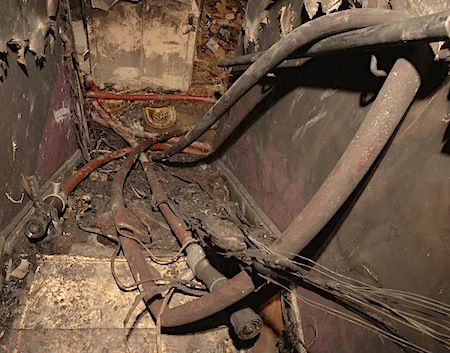Amendment 3 to BS 7671: 2008 is now published. One notable result is the introduction of life-saving legislation that will help prevent fatalities from cable entanglement will be included in UK Wiring Regulations. This is, in part, because of successful lobbying from Electrical Safety First, as James Hunt reports:
Electrical Safety First, working in collaboration with Fire and Rescue Services, has led to a notable change in Amendment 3 of the IET Wiring Regulations, BS 7671: 2008 (to be published in a few days), which will compel all new wiring systems to use metal, rather than plastic, to support cables in escape routes, to prevent their premature collapse in the event of a fire.
In recent years, there have been some tragic outcomes when falling cables have trapped both those trying to escape and the fire fighters trying to save lives. One of the incidents, which led to the new requirement, was the death of two fire fighters tackling a blaze in a single flat on the ninth floor of Southampton high-rise, Shirley Towers, where fallen cables were found to be one of the contributory factors in the tragedy.
The fire fighters had been confronted by an intense blaze and became trapped when the electrical wiring in the ceiling-mounted trunking fell because the supports holding them up had melted in the heat.
ALL supports non-combustible in escape routes
The new requirement will apply only to cables within escape routes that are fixed to the surface of walls or the underside of ceilings. But it is important to note that – as is the case with supports for cables for fire detection, fire alarms and emergency lighting systems – all supports for cables in escape routes should be of non-combustible material such as metal.
Explained Martyn Allen, Head of the Electro-Technical Division at Electrical Safety First: “Past experience has shown that, where installed at high level in corridors, stairways and other escape routes (and in high rises blocks particularly), cables supported only by plastic cable clips or by plastic trunking, or conduit without additional metal supports, can pose a significant risk during a fire - to both residents and those attempting to rescue them.
“We are delighted that our partnership approach to this issue, working with the Chief Fire Officers Association (CFOA) and other key stakeholders, has led to this important addition to BS 7671 and a step-change improvement in safety,” he said.
Commented John Bonney, Chief Officer at Hampshire Fire and Rescue Service: “Following the death of our two colleagues, Alan Bannon and James Shears, at Shirley Towers, the Coroner found that fallen cables – which hampered their attempts to escape - were a key factor in the tragedy. The Coroner recommended a change to the legislation around cable support and we have lobbied hard over the last two years, through CFOA, to bring this about.
“While we cannot undo what happened at Shirley Towers, or other fatal fires where cables have been a factor, this small but vital regulatory change will help protect both the public and fire fighters and prevent them facing similar dangers in the future.”
A life saving improvement
Andy Reynolds, CFOA Lead Officer for Electrical Safety, added: “A new regulation in the wiring regulations has been brought about thanks to the hard work of Electrical Safety First and a successful partnership with the CFOA. This regulatory change is a significant life-saving improvement.”
CFOA is a professional membership association and a registered charity. CFOA members are drawn from all UK Fire & Rescue Services (FRSs) representing the senior executives and managers of the Service.
More about Amendment 3
To learn much more about Amendment 3 to BS 7671: 2008, keep an eye open for your next VoltiTECH technical e-newsletter, which will be published early in January 2015 – this will be largely about Amendment 3 and ALL of its effects, not just non-combustible cable supports.
More about Electrical Safety First
Electrical Safety First is the leading UK charity committed to preventing deaths and accidents arising from electricity. The organisation’s aim is to ensure everyone in the UK can use electricity safely, and it campaigns on behalf of consumers and electrical trade professionals to improve safety regulation and ensure safety messages are appropriate, up to date and well communicated.
Electrical Safety First (
http://www.electricalsafetyfirst.org.uk/) provides expert information and advice to help people protect themselves from faulty, damaged, sub-standard, and poorly maintained electrical installations and electrical appliances. It is recognised by government and industry as the leading campaigning charity and technical authority on electrical safety.
